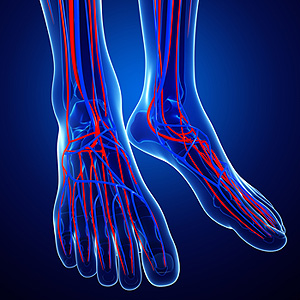NJ (908) 688-5577
NY (212) 737-2528
 High blood pressure may be one of the more common causes of poor circulation in the feet and toes. When this occurs, the pressure the artery walls must endure is greater than normal. General symptoms may include discomfort and pain, which may typically happen during walking or exercise. Additional symptoms may include cramping, tingling, numbness or pain, which may become severe. Patients may experience a change in color in their lower extremities and they may notice sensitivity and coldness in their feet and toes. There are steps that can be implemented which may prevent circulation problems including ingesting fresh foods which may aid in maintaining a healthy weight, eliminating smoking and practicing a daily exercise program. It’s suggested to consult with a podiatrist who can provide the necessary medical advice if you have discovered you have poor circulation in your feet.
High blood pressure may be one of the more common causes of poor circulation in the feet and toes. When this occurs, the pressure the artery walls must endure is greater than normal. General symptoms may include discomfort and pain, which may typically happen during walking or exercise. Additional symptoms may include cramping, tingling, numbness or pain, which may become severe. Patients may experience a change in color in their lower extremities and they may notice sensitivity and coldness in their feet and toes. There are steps that can be implemented which may prevent circulation problems including ingesting fresh foods which may aid in maintaining a healthy weight, eliminating smoking and practicing a daily exercise program. It’s suggested to consult with a podiatrist who can provide the necessary medical advice if you have discovered you have poor circulation in your feet.
While poor circulation itself isn’t a condition; it is a symptom of another underlying health condition you may have. If you have any concerns with poor circulation in your feet contact Glenn Davison, DPM of Advanced Podiatry. Our doctor will treat your foot and ankle needs.
Poor Circulation in the Feet
Peripheral artery disease (PAD) can potentially lead to poor circulation in the lower extremities. PAD is a condition that causes the blood vessels and arteries to narrow. In a linked condition called atherosclerosis, the arteries stiffen up due to a buildup of plaque in the arteries and blood vessels. These two conditions can cause a decrease in the amount of blood that flows to your extremities, therefore resulting in pain.
Symptoms
Some of the most common symptoms of poor circulation are:
Treatment for poor circulation often depends on the underlying condition that causes it. Methods for treatment may include insulin for diabetes, special exercise programs, surgery for varicose veins, or compression socks for swollen legs.
As always, see a podiatrist as he or she will assist in finding a regimen that suits you. A podiatrist can also prescribe you any needed medication.
If you have any questions, please feel free to contact our offices located in Union, NJ and New York . We offer the newest diagnostic and treatment technologies for all your foot care needs.